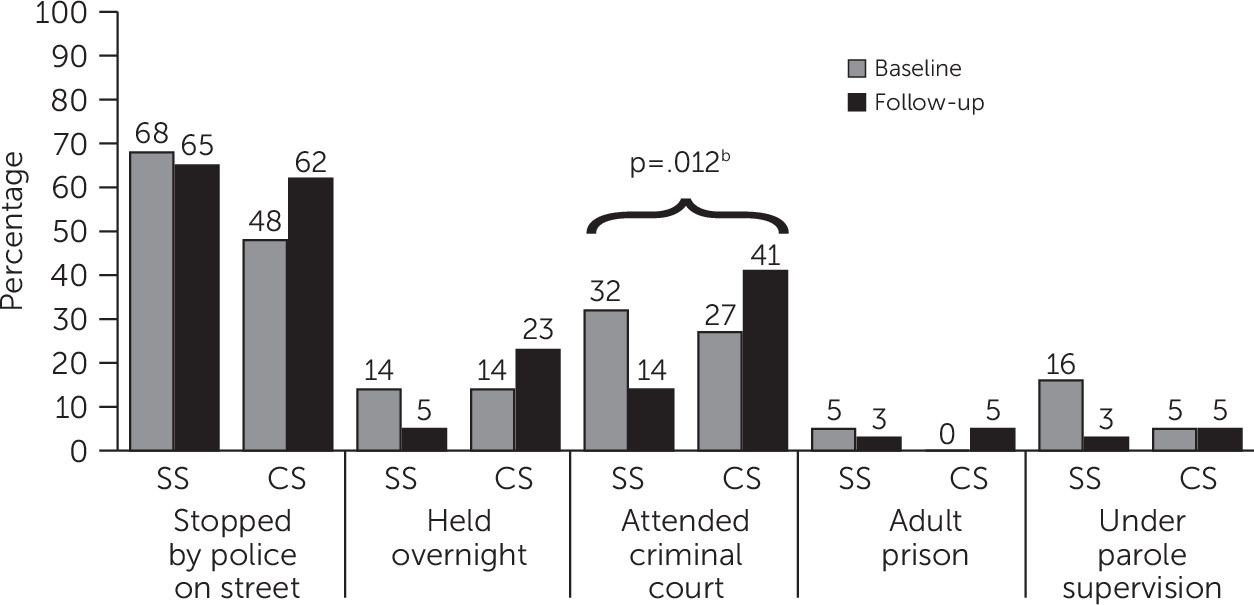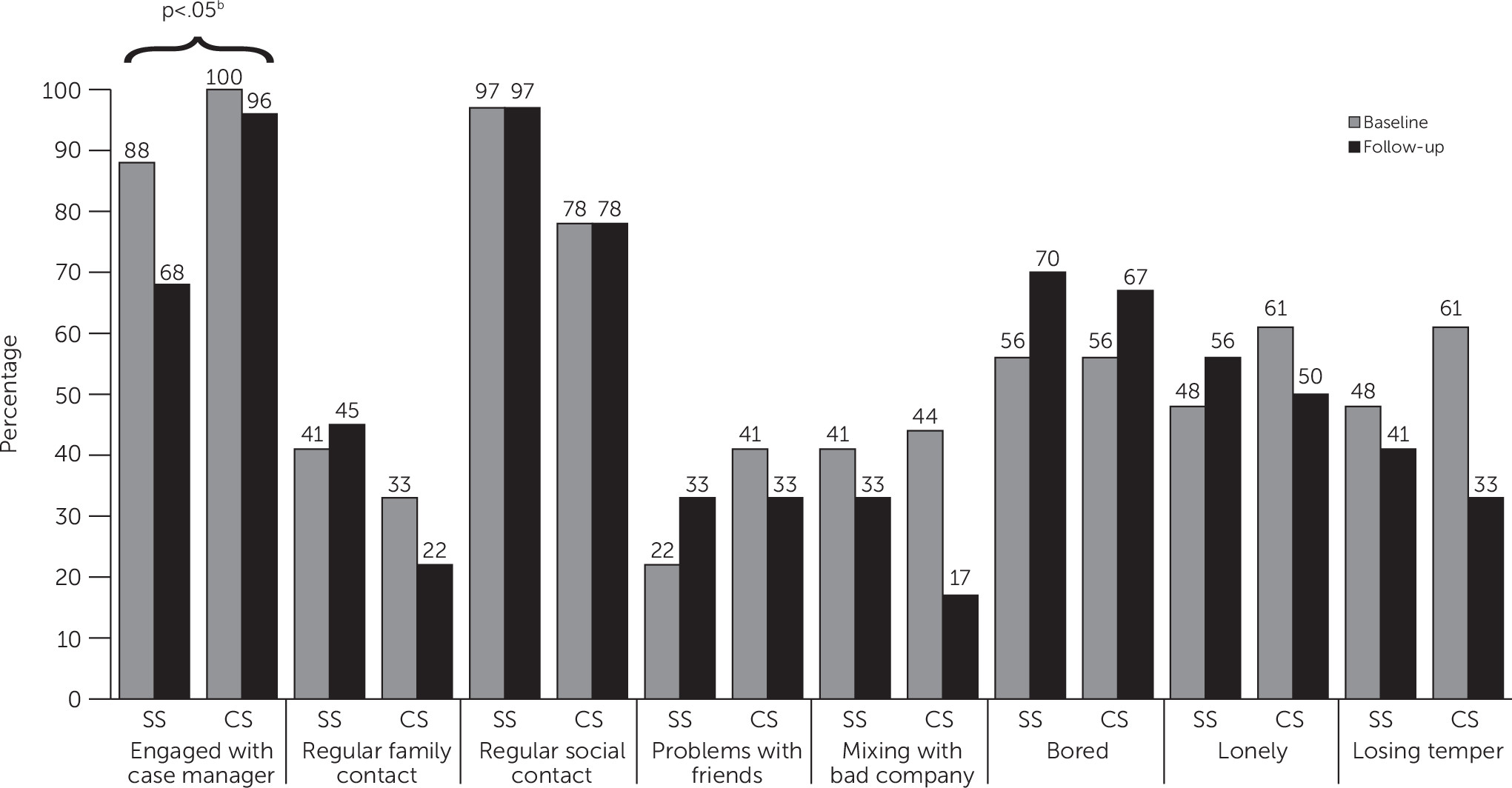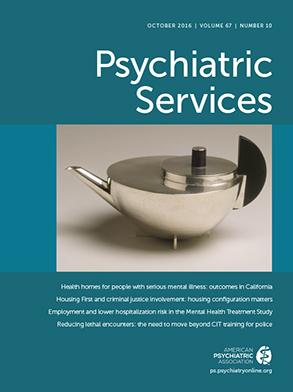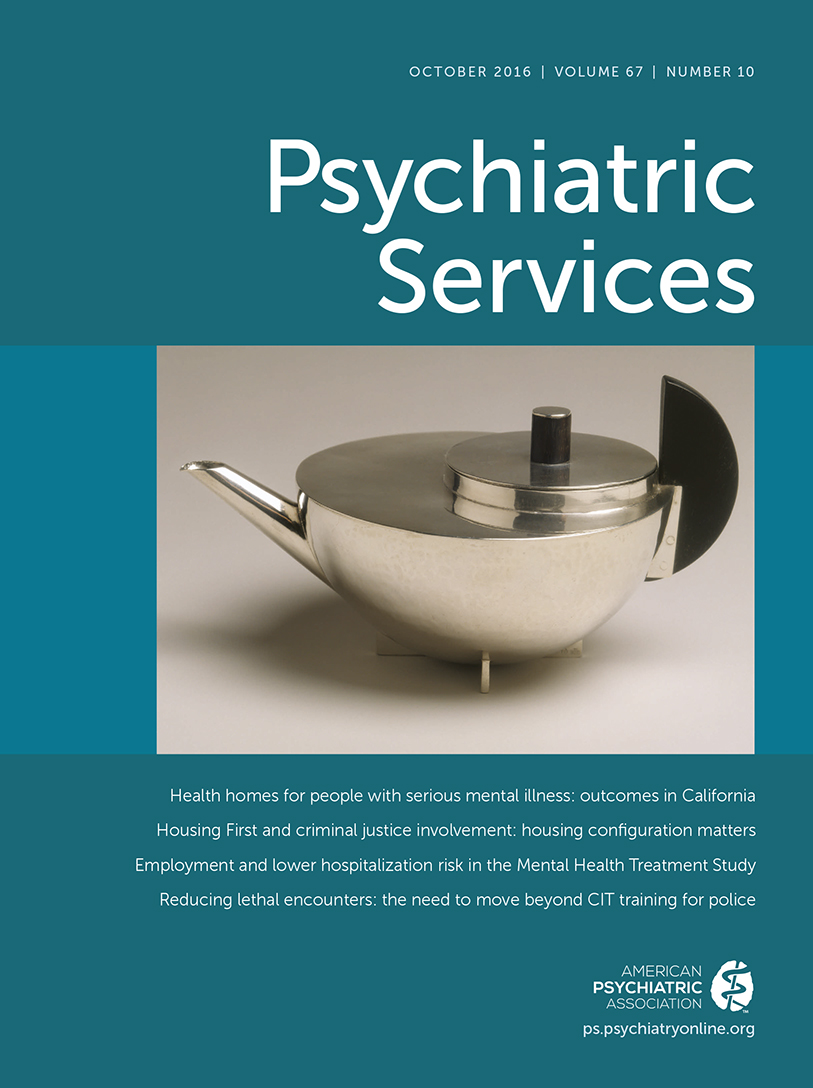Homeless individuals are more frequent users of health and criminal justice systems and incur relatively higher costs for these services compared with the general population (
1–
4). Lack of access to stable housing is associated with a range of negative outcomes, including increased criminal involvement, lower quality of life, and fewer social connections (
5,
6). The co-occurrence and seriousness of these outcomes, combined with the structural barrier of housing access, led to the development and implementation of Housing First, a novel approach in which homeless individuals with complex needs are rapidly allocated long-term housing with attached support (
7).
Since its inception in New York City in 1992 within the Pathways to Housing organization (
8), Housing First has been adapted across a number of countries. Both Canada and Australia have implemented Housing First programs by using two configurations of housing and support: scattered site (SS) and congregate site (CS). Briefly, the SS configuration houses individuals in private rental properties scattered across a city and includes home visits from case managers. The CS configuration houses individuals within a socially integrated housing complex of apartments with on-site services. Although both forms of housing and attached support adhere to the Housing First philosophy, researchers have emphasized the need to understand whether these configurations are associated with differences in outcomes (
9).
Overall, reductions in criminal justice system contact have been found among Housing First residents, including those with mental disorders (
10) and severe alcohol problems (
11,
12). One longitudinal study found that Housing First residents were less likely to engage in criminal activity when they were stably housed compared with when they were homeless (
13). An experimental study in the Canadian city of Vancouver recently found improvements in criminal justice system outcomes among participants in Housing First compared with individuals who received treatment as usual, which included access to existing emergency shelters, case management, and supportive-housing units (
14). Although the study comprised both SS and CS configurations, no formal comparisons were made between these two configurations. However, the authors hypothesized that the SS configuration may have had greater benefits for individuals’ housing retention, health, and justice system involvement compared with the CS configuration, given that the SS residents occupied separate dwellings in established communities with typically high public order and low crime. By comparison, individuals in the CS configuration were rapidly housed together in a higher-density, downtown neighborhood, which was posited to have exposed residents to a higher risk of criminal involvement.
Although a relationship between housing stability and crime has been well established among individuals with homelessness histories, there is less evidence on the relationship between homelessness and quality of life and social connectedness. Research has shown that individuals with histories of homelessness and criminal offenses who were placed in independent housing reported higher quality of life and greater social connections compared with their counterparts who were either homeless or who lived in dependent housing (someone else’s home or an institution) (
5,
15). However, a recent randomized trial found no differences in quality-of-life scores over 24 months among participants assigned to Housing First with intensive case management and participants who received access to existing housing and support services (
16). As such, the evidence base on the relationship between the provision of housing and outcomes for crime, quality of life, and social connectedness among persons with histories of chronic homelessness is very much undeveloped.
Although results to date suggest Housing First programs reduce criminal engagement among residents (
14), identifying whether the configuration of housing (SS versus CS) has a differential impact on criminal engagement has not been formally examined. Yet addressing this issue is critical, given that SS and CS Housing First configurations have been rapidly expanded, despite a limited evidence base and often high capital costs. The aim of this study was to compare changes over time between criminal justice, quality-of-life, and social connectedness outcomes among previously homeless people housed in SS and CS configurations.
Methods
Study Design
Full details of the study design, including details about the measures used, have been published elsewhere (
17). Briefly, a longitudinal, quantitative design was used to compare individual outcomes at baseline and 12-month follow-up for two Housing First programs in Sydney, Australia—one using an SS configuration (private rental-market dwellings sublet through a community housing provider) and one using a CS configuration (public housing on one site). Although allocation into the SS and CS programs occurred prior to this study and was not randomized, eligibility criteria for entry into both configurations were the same. The methodology, conduct, and reporting of this study were in accordance with the Strengthening the Reporting of Observational Studies in Epidemiology (STROBE) initiatives for cohort studies (
18). [STROBE recommendations for reporting cohort studies are available as an online
supplement to this article.]
Ethical approval was granted by the New South Wales (NSW) Population and Health Services Research Ethics Committee and the Human Research Ethics Committee of the University of New South Wales Australia.
Recruitment
Initially case managers approached eligible SS and CS clients to determine whether they would consent to be contacted by a trained researcher to explain the study. Eligible participants were 18 years or older, had a chronic history of homelessness (defined in Australia as “sleeping rough” for at least six months), and were currently engaged with the SS or CS program [see online supplement for a flowchart of the recruitment process]. Eighty of 122 (66%) eligible clients (45 of 70 clients recruited from SS and 35 of 52 clients recruited from CS) provided written informed consent and were administered the face-to-face baseline survey by a trained researcher, which took 45 minutes to complete. Given the relatively small number of clients in the programs and the complexity of their needs, baseline data were collected during a specific time interval (November 2012–May 2013) rather than on program entry.
Participants were contacted again after 12 months to complete the follow-up survey, which took place, on average, 12.7±1.3 months after the baseline survey (October 2013–May 2014). In total, 63 (79%) participants (37 SS clients and 26 CS clients) who were interviewed at baseline consented and completed the follow-up survey [see the online supplement for a summary of participation at baseline and 12-month follow-up and a description of the follow-up process]. Participants received a food voucher for $40 (Australian dollars) at the conclusion of each survey as reimbursement.
Measures
Sociodemographic characteristics.
Measures were sex, age (years), having slept rough for five years or more cumulatively, indigenous status, country of birth (Australia or other), completion of grade 10, being in a relationship, number of children, and no current employment. The Montreal Cognitive Assessment (MoCA) was administered to identify mild cognitive impairment, the clinical state that often precedes dementia (
19). Participants self-reported the number of general medical and psychiatric diagnoses made by a medical practitioner and specifically whether they had a substance use disorder diagnosis. Although eligibility was not dependent on having a mental disorder, both groups self-reported a median of 2.0 psychiatric diagnoses from a medical practitioner, and consequently examining the outcomes among a sample of individuals with chronic homeless histories and often with at least one mental disorder was a major focus of this study.
Criminal justice system engagement.
Engagement with the following criminal justice system channels over the past 12 months was assessed: stopped on the street by police, held overnight by police, attended court for a criminal matter, been incarcerated in an adult prison, and been supervised by a parole or other justice officer. A total score was calculated by adding the number of various types of criminal justice system interactions over the prior 12 months, with possible scores ranging from 0 to 5.
Quality of life.
The World Health Organization Quality of Life–BREF (WHOQOL-BREF) is a standardized, 26-item questionnaire that measures quality of life in the domains of environment and social relationships. On a 5-point Likert scale, participants rate the degree to which they experienced each item during the two weeks prior to the survey. Possible scores range from 0 to 100, with higher scores indicating greater quality of life. The questionnaire has been validated among individuals who have experienced chronic homelessness (
20).
Social connections.
Current engagement with a case manager and contact in the prior week with family or other people were assessed. Participants reported whether they had experienced the following social problems in the past month: problems with friends, mixing with bad company, feeling bored, feeling lonely, and losing their temper.
Data Analysis
Data were analyzed by using SPSS, version 22.0. Profiles of participants from the two configurations were compared on the basis of demographic, health status, and homelessness history measures. We calculated unadjusted means and proportions for outcomes (engagement with the criminal justice system, quality of life, and social connections) for each group, as well as within-group changes, at baseline and follow-up. Finally, we estimated the difference in outcomes between housing configurations at follow-up for various dependent variables; these analyses were conducted with multiple linear or logistic regressions, depending on the nature of the dependent variable, and were adjusted for potential confounding effects of baseline housing duration. We also adjusted for the baseline value of the outcome to control for any potential baseline differences. The assumptions of the regression models were assessed through graphical examination of residuals.
Results
Sociodemographic Characteristics
There were no meaningful differences in sociodemographic characteristics between the two groups at baseline, with the exception of housing duration, which was significantly longer for CS residents compared with SS residents (t=2.61, df=61, p=.01) (
Table 1). The majority of participants were male and born in Australia; the mean age was approximately 44 years. Less than one-fifth identified as indigenous, and over half reported a history of sleeping rough for five years or more. Most participants screened positive for some degree of cognitive impairment, and participants reported a median of four general medical conditions and two mental disorders. Fifty-four percent of SS participants and 35% of CS participants reported a substance use disorder.
Criminal Justice System Engagement
A significant between-group difference was found for the mean number of criminal justice system channels with which participants had engaged (adjusted effect=–.3); that is, from baseline to follow-up the number of contacts with criminal justice channels decreased from 1.4 to .9 among SS participants and increased from .9 to 1.3 among CS participants (
Table 2). This finding was mirrored in the proportions of participants who had contact with each type of justice system channel at least once in the 12 months prior to the follow-up interview (
Figure 1). Most notably, there was a significant between-group difference in the odds of attending court for a criminal matter (adjusted odds ratio [AOR]=19.8), whereby the percentage of participants attending court decreased over time among SS participants and increased over time among CS participants.
Quality of Life
No significant between-group differences were found for the environment or social relationships measures on the WHOQOL-BREF over time (
Table 2). Furthermore, no changes were observed for the environment measure within either the SS or CS group. The score for social relationships increased significantly among CS participants over time (from 55.0 to 68.3), whereas the social relationship score remained relatively stable for the SS participants.
Social Connections
Fewer SS participants reported engagement with a case manager over time (from 88% to 68%) compared with CS participants (from 100% to 96%) (
Figure 2). SS participants were significantly more likely than CS participants to have disengaged from their case manager in the 12 months prior to the follow-up interview (AOR=10.9). No between-group differences were found for regular contact with family members or other people or for the social problems measured. Although not significant, two notable trends emerged. First, the percentage of SS participants who reported a problem with feeling bored increased over time (from 56% to 70%). Second, there was a reduction at follow-up in the percentage of CS participants who reported losing their temper (from 61% to 33%).
Discussion
Our study is the first to examine the differential impact of SS and CS Housing First configurations on individuals’ criminal justice system contact, quality of life, and social connections. Two key findings emerged. First, criminal justice system contacts decreased significantly among SS participants and increased significantly among CS participants over 12 months. Second, SS and CS groups did not differ significantly on quality of life or social connectedness measures, with the exception of engagement with case managers, whereby there was a greater decrease in SS participants engaging with a case manager over time compared with CS participants.
Our first key finding of a differential impact of housing configuration on criminal justice contact extends previous literature that has found decreases in justice system involvement, including reduced arrests and incarcerations, among participants in a single configuration of Housing First (
11,
12). Somers and colleagues (
14), who compared SS and CS with treatment as usual, found reductions in offending and reconviction among individuals with homelessness histories and mental disorders in both housing configurations, albeit the SS sample recorded a greater reduction.
Our results partially support prior findings of a reduction of justice system contacts among Housing First residents, given that we found a decrease among SS participants but an increase in justice system contacts among CS participants. However, the explanation for these trends may be related to the environment and social norms associated with the configurations rather than to individual characteristics. For example, compared with CS participants, a higher proportion of SS participants reported a substance use disorder, a diagnosis that is associated with increased criminal activity. Yet SS participants reported fewer criminal justice contacts than the CS sample. This finding may be related to the fact that SS participants were housed in private rental apartments that varied in proximity to Sydney’s city center, with neighbors comprising single persons, couples, and families who may have provided opportunities for positive social modeling.
In contrast, most CS residents were housed relatively quickly in a newly opened building with no preexisting social norms. The CS building was located next to a public housing complex, and anecdotal reports suggested that the public housing residents engaged in activities that resulted in police attendance. Scrutiny of residents was also higher for the CS configuration compared with the SS configuration, with on-site case managers and 24-hour security personnel providing constant surveillance of residents. These factors may have resulted in heightened police presence and reporting of crime. Other anecdotal reports suggested that the increase in CS court appearances may have been due to encouragement by on-site case managers for residents to deal with outstanding criminal matters. The argument that increased court appearances may have been an indirect effect of the CS case managers supports previous research that found jail recidivism rates were higher among clients who had a case manager compared with those who did not (
21).
Quality-of-life dimensions for environment and social relationships remained mostly stable for SS and CS participants alike; however the CS configuration appeared to be associated with significant improvements in participants’ social relationships over time. Similarly, we found comparable changes in the social connectedness variables across 12 months for the SS and CS groups, except the percentage of participants who engaged with a case manager decreased more among SS participants compared with the CS sample. This finding is not surprising, given that the SS configuration is designed to help clients establish residence in an independent-living setting (a private rental property), connect with mainstream services, and disengage from specialized case management. Conversely, the CS building was designed for the purpose of providing ongoing case management for residents.
The majority of individuals at both sites reported boredom as an increasing problem, although moreso among SS participants. There was also a notable decrease in the proportion of CS participants who reported losing their temper as a problem at follow-up. Similar findings have emerged in qualitative Housing First research (
22–
25), particularly among individuals with a substance use disorder. These findings suggest that although the Housing First approach appears to be successful at achieving housing stability, helping clients connect socially within their communities may be a greater challenge. Yanos and colleagues (
26) found that the level of social integration between people with mental disorders and their neighbors was predicted by the length of time during which persons with mental disorders had resided in their home. Therefore length of residency could be an important factor contributing to boredom. Our study lasted only 12 months, and it may have been more difficult for SS participants to connect with their neighbors in that time frame compared with participants in the CS configuration, which facilitated direct and daily interaction with neighbors who lived within the complex. Given that social connectedness is well established as a protective factor for both mental illness and substance use disorders (
27,
28), it would be beneficial to identify whether social connectedness improved over time and if it had a positive impact on adverse outcomes, such as crime, among persons housed in both SS and CS configurations.
Our study had several limitations. First, participants were not randomly assigned to SS and CS groups, although both programs were administered independently and used the same eligibility criteria. Second, baseline interviews were conducted at a set point in time, and as such, participants had been housed prior to baseline for differing lengths of time. Differences in length of housing prior to baseline may have affected the change scores observed; however, the analyses were adjusted for baseline housing duration. Third, the study relied upon self-report data and did not have access to administrative data on health and justice contacts (
7). Last, the very nature of these programs (small scale and high cost) led to small samples. However, significant resources were invested to maximize recruitment and follow-up, as demonstrated in the relatively high follow-up rates for this population.
As for strengths, the samples used in this study comprised chronically homelessness individuals with varying comorbidities, including mental disorders and cognitive impairment, and were representative of the recruitment population and similar to each other in terms of sociodemographic composition (
17). Because these factors increase the generalizability of findings to the chronically homeless population in Sydney, we are confident that the results provide strong evaluative evidence of the SS and CS Housing First programs within an Australian setting.
Conclusions
This study is the first, to our knowledge, to directly compare the outcomes of previously homeless individuals in SS and CS Housing First configurations. The research is also timely, given the rapid expansion of both configurations in Australia and internationally. This study shows that housing configuration had a differential impact on crime outcomes. Furthermore, preliminary findings suggest that the SS housing configuration may have been associated with greater problems of social isolation. Thus the level of social connectedness of various Housing First configurations should continue to be examined. It is critical that further research be undertaken to identify how Housing First programs might be best configured to suit individuals with histories of chronic homelessness who have complex needs, particularly in environments of affordable-housing shortages.
Acknowledgments
The authors acknowledge the study participants, stakeholders, and other researchers who assisted with the data collection, including the Social Policy Research Centre, UNSW Australia, which led the evaluation of the congregate-site housing program.



